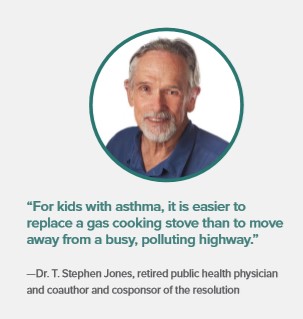We appreciate the mitigation to prohibit natural gas infrastructure in new residential and commercial projects. However, to be right in addressing the added impact of vulnerability to Covid-19 and Environmental Justice, there must be a program to replace gas stoves and indoor air pollution exposure from natural gas in existing structures, starting with low-income and people of color. These emissions significantly add to cumulative effects from multiple sources. There is urgent and critical need for a program to implement a health-based indoor air quality guideline that protects the most sensitive populations, including children, the elderly, and those with existing respiratory ailments.
Air pollutants from gas stoves include the following:
- Particulate Matter (PM2.5) in the absence of cooking food (i.e. from the flames) can be 2X higher from gas than from electric.
- NO2 and NO (NOx) associated with combustion sources. NOx levels are close to zero in electric homes. Average levels in homes with gas stoves are from 50% to over 400% higher than in homes with electric stoves.
- Nitric Oxide (NO) a precursor to NO2; there are significant levels only from gas stoves.
- Carbon Monoxide (CO) risk is substantially elevated in homes with gas stoves.
- Formaldehyde (CH2O or HCHO) is a known human carcinogen. Exposures at levels that occur in homes have been associated with infections in the lower respiratory tract. Simmering on low heat for multiple hours can produce significant levels of formaldehyde fumes if ventilation is lacking (or the hood fan is not turned on).
Impacts from gas stoves:
- Indoor air is largely unregulated and is more polluted than outdoor air.
- Toxic pollutants are at levels that would be illegal outdoors.
- Increased risks to respiratory health well documented.
- Children are at higher risk because of their higher breathing rates and levels of physical activity, higher lung surface to body weight ratios and smaller bodies, and immature respiratory and immune systems.
- Lower-income households are at higher risk.
- Ventilation and other strategies are critical to protect vulnerable segments of the population.
- Electric cooking is cleaner.
Research data on health risks to children from NO2 from gas stoves:
- Asthmatic children are at higher risk for more severe asthma symptoms at low
levels of NO2 and the risk rises as NO2 rises. Belanger et al, “Household levels of nitrogen dioxide and pediatric asthma severity”, Epidemiology 24(2), March 2013, 320-330, https://www.ncbi.nlm.nih.gov/pmc/articles/PMC3686297
- A meta-analysis showed children’s risk of wheeze increased by 15 percent for every15-ppb increase in NO2. Ruifeng Li et al., Association of indoor nitrogen dioxide with respiratory symptoms in children: Application of measurement error correction techniques to utilize data from multiple surrogates, Journal of Exposure Science & Environmental Epidemiology 16, 2006, https://doi.org/10.1038/sj.jes.7500468
- A 15-ppb increase in NO2 corresponded to a 50 percent increase in annual risk for respiratory symptoms among children and adolescents. Health Canada, Residential Indoor Air Quality Guideline: Nitrogen Dioxide, 2015, p. 10 https://www.canada.ca/en/health-canada/services/publications/healthy-living/residential-indoor-air-quality-guideline-nitrogen-dioxide.html
- Childhood wheeze, cough, and chest tightness all the way to severe chronic obstructive pulmonary disease. Integrated Science Assessment (ISA) For Oxides of Nitrogen – Health Criteria (Final Report, 2016). US Environmental Protection Agency, Washington, DC, EPA/600/R-15/068, 2016, p. 1-17, 5-55, https://cfpub.epa.gov/ncea/isa/recordisplay.cfm?deid=310879
- Elevated levels of NO2 may be linked to cardiovascular effects, diabetes, cancer, and reproductive effects. Integrated Science Assessment (ISA) For Oxides of Nitrogen – Health Criteria. https://cfpub.epa.gov/ncea/isa/recordisplay.cfm?deid=310879.
- Combustion related air pollution is linked with adverse brain development. Devon C. Payne-Sturges et al., “Healthy Air, Healthy Brains: Advancing Air Pollution Policy to Protect Children’s Health,” American Journal of Public Health 109, 2019, https://doi.org/10.2105/AJPH.2018.304902
- Infant through preschool-age early-life exposure to indoor air pollution from gas appliances may be related to impaired cognitive function and may increase the risk of developing attention-deficit/ hyperactivity disorder (ADHD) symptoms. Eva Morales et al., “Association of Early-life Exposure to Household Gas Appliances and Indoor Nitrogen Dioxide with Cognition and Attention Behavior in Preschoolers,” American Journal of Epidemiology Vol. 169, No. 11, June 2009, https://doi.org/10.1093/aje/kwp067.
Further evidence and references to these negative impacts can be found in the April 2020 publication “Effects of residential gas appliances on indoor and outdoor air quality and public health in California,” from the UCLA Fielding School of Public Health https://ucla.app.box.com/s/xyzt8jc1ixnetiv0269qe704wu0ihif7 and this May 2020 publication by the Rocky Mountain Institute https://rmi.org/insight/gas-stoves-pollution-health/. Public health physicians advocating against gas stove pollution have said, “For kids with asthma, it is easier to replace a gas stove than to move away from a busy, polluting highway.”
In addition to long-range state goals to decarbonize all structures, the following mitigations of indoor air pollution from gas stoves are of utmost importance in light of the connections between lung health, Covid-19 outcomes, and marginalized populations.
- That residents have access to knowledge in all appropriate languages about the risks and available protections to be safe from harmful levels of gas stove pollution.
- That gas stove pollution be eliminated in all publicly funded buildings as soon as practical, with a focus on buildings that house children and other at-risk populations. Public funds, including for schools and low-income housing, should not be used to purchase or install indoor appliances that expose occupants to harmful levels of gas stove pollution.
- That financial incentives, such as tax credits or rebates, are provided to enable low-income homeowners to eliminate gas stove pollution, including adding plug-in induction stovetops or switching from gas to electric stoves. Prioritize homes with children and other at-risk populations.
- That landlords provide notice to new and existing tenants about the risk of gas stove pollution, including options to minimize gas stove pollution such as offering induction cooktops, gas stove replacement, and stovetop ventilation to the outdoors.
These mitigations will contribute to a measurable decrease in GHG emissions to help the county achieve what should be a goal of net zero carbon as soon as possible and no later than 2030.

